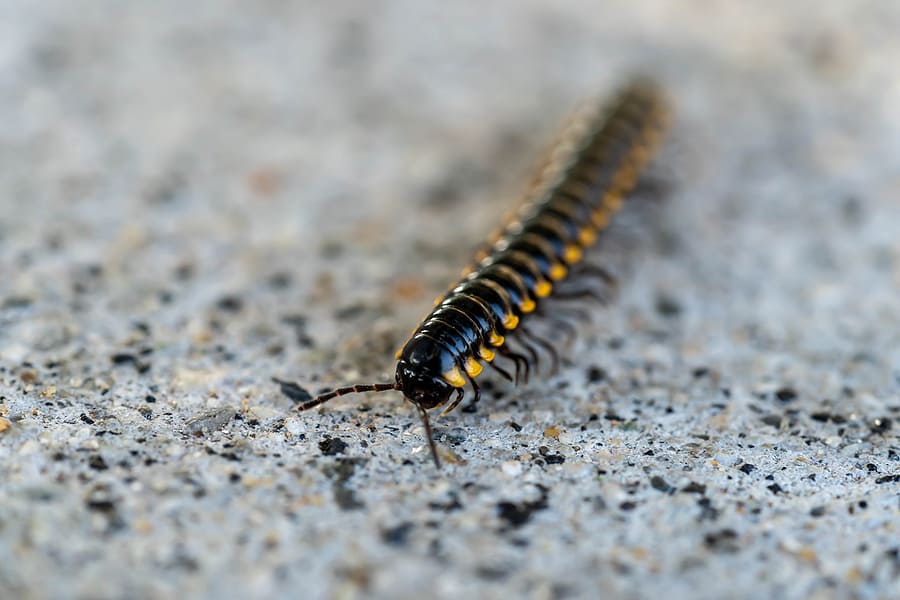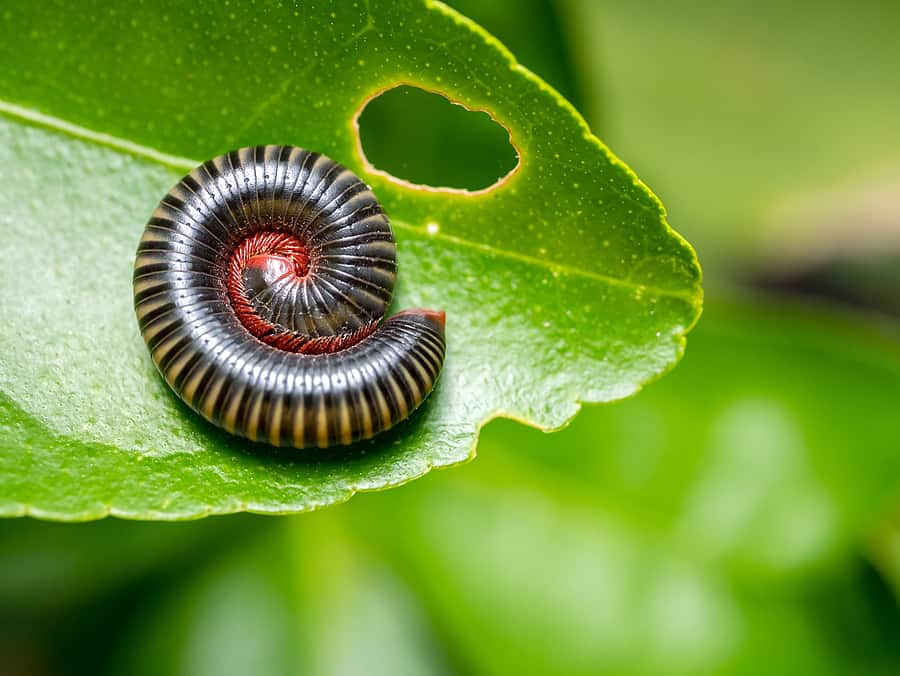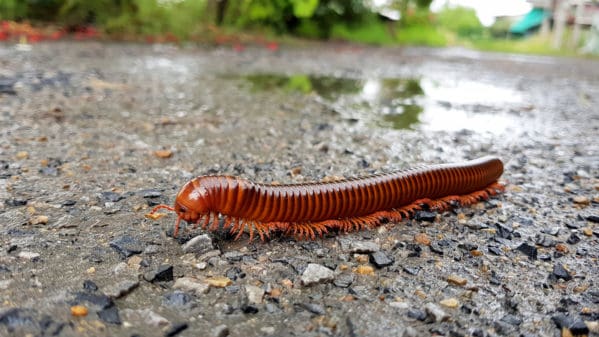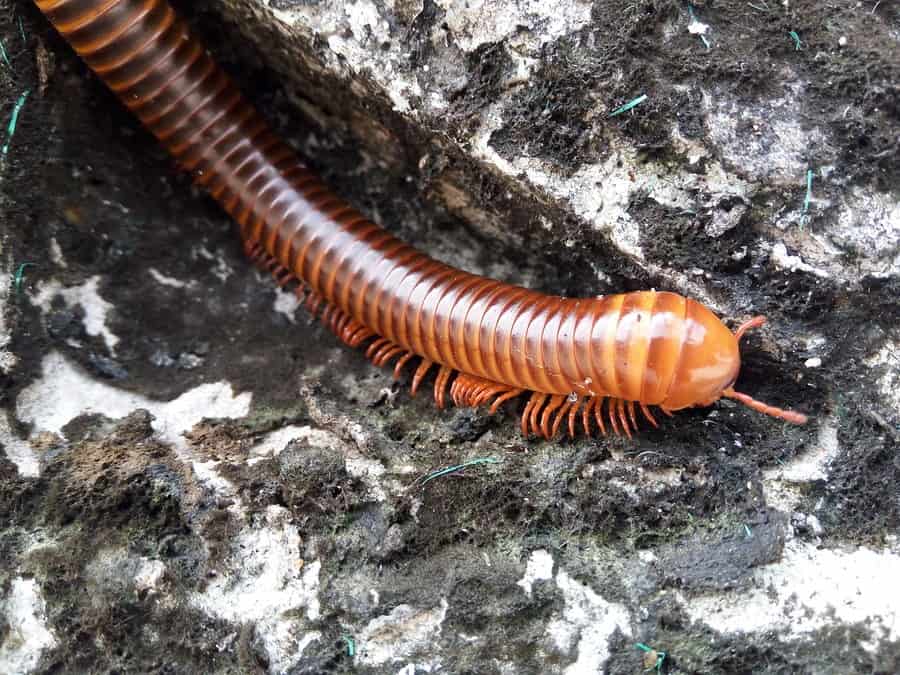READY TO GET STARTED?
REQUEST A FREE ESTIMATE
Fill out the form below or call (888) 466-7849 for a free, no-obligation estimate.

Although they are often confused with each other, millipedes and centipedes are two completely different pests. While both are classified as arthropods, the similarities end there. Which one is more dangerous to humans – millipede vs centipede?
Centipedes have bodies composed of many segments with one pair of legs on each segment. These long legs extend from the sides of their bodies and trail backwards behind them, making them very visible. These legs enable centipedes to move very quickly. They also have long antenna. Centipedes do have the capability to bite and are classified as predators, killing and eating their prey.
Millipedes, on the other hand, are the opposite. These arthropods have only 1 pair of legs on their first 3 body segments but then two pairs of legs for each body segment after those. Their legs are shorter and do not trail behind their bodies like centipedes do. These shorter legs make millipedes move much slower than their long-legged counterparts. Millipedes are also unable to bite. They are scavengers and do not kill prey to feed.
So which one is more dangerous? When millipedes are disturbed they will curl into a tight ball similar to a pill bug or “roly poly.” Since they are unable to bite, they emit a foul-smelling fluid that can cause irritation to the skin and eyes of humans if handled. Centipedes, on the other hand, will bite humans on occasion if they are disturbed. A centipede bite is similar to that of a bee sting, leaving behind a red bump that can swell, itch or sting. Despite these defensive mechanisms, neither millipedes nor centipedes are considered dangerous to humans or pets. Neither of these pests are known to transmit diseases or contaminate food, furniture, or plants either.
Although they aren’t considered harmful to humans, we still tend to be a little leery of their presence. You can prevent millipedes and centipedes by:
If you have a problem with millipedes or centipedes, contact your local pest control company who can help identify which of these pests you have, as well as help identify how they are getting into your home and the best method to eliminate them and prevent them from returning.
Avoiding Stinging Pests at Your Business
Controlling Birds During the Summer Months

Millipedes are long, wormlike animals that are also referred to as worms, wireworms, and armyworms. While often mistaken for centipedes, millipedes are smaller (1 to 1-1/4 inches in length) with dark brown coloring and shiny, hard shells. They have long cylindrical bodies and have a habit of curling into a ball when they are disturbed. While the name millipede might imply they have thousands of legs, in reality they typically have 4 legs per body segment and at least 60 legs total, although some species can have up to 160 legs. Millipedes are harmless to humans as they cannot sting or bite. They also do not feed on plants or wooden structures. What they do feed on is decaying plant material and prefer damp, moist environments where they thrive. They are often found under leaves, plant debris, mulch, pine needles and other similar habitats.
While there is no set millipede season, they do go on mass migrations twice per year – once in the spring and once in the fall. These usually occur on warm, humid nights where they will emerge by the hundreds. Millipedes are outdoor pests so finding them inside your home means they have wandered in by mistake. In fact, millipedes cannot reproduce indoors. When these pests do make their way indoors, they are often found in garages and basements. Millipedes are nocturnal when they wander out of their hiding places roaming aimlessly. They eventually crawl back into holes or cracks (oftentimes in our homes) to escape the dryness of the impending daytime. They can often be found hiding under the edge of the garage door, in cracks along the exterior of your home, in sidewalk or driveway cracks, and in the gaps of your foundation.
Although millipedes are harmless, they can become a nuisance when they make their way into your home en masse. While there is no definitive millipede control method, the best practice is to try and keep them outdoors as best as possible. Because they often wander in through cracks and gaps, make sure these and other entry points around doors, windows, and foundations are sealed. They feed on organic material so keeping mulch, pine needles, and dead leaves away from your home will also help. Ensure gutters are not clogged and downspouts are angled away from foundations as this dampness will attract them in droves. Using insecticides on millipedes indoors is usually considered unnecessary as they will die in a short period of time due to lack of moisture. The best option to get rid of them indoors is to sweep or vacuum them up and discard them. Once the cold weather hits, they will become dormant… at least until springtime rolls around again!
If you have a problem with millipedes or any other household pests, contact your local pest control company for a free analysis.
Spring Cleaning to Keep Pests Out
Termite Control: Protecting Your Home From Termite Damage

Millipedes are common occasional pests that are found throughout the United States. While they typically live outdoors under leaves, mulch, compost, rocks, etc, they will come indoors for two reasons: in search of water during droughts or in search of shelter after heavy rains. They are often found infesting basements, garages, and crawlspaces. If you spot millipedes in your house, it is highly likely that they are breeding somewhere in your lawn.
Millipedes are decomposers meaning their diet primarily consists of damp, decaying plant material. Because of this, they are quite beneficial to have in your garden. While they are harmless to humans, millipedes can become a nuisance if they infest your home in large numbers. Prevention is the best method of millipede control. Here are some tips you need to know about how to keep millipedes away from your home.
If there is nowhere for millipedes to hide or breed then they can’t infest your home. Prevent millipedes by removing mulch, leaves, grass clippings, boards, woodpiles, rocks, boxes, etc. from your yard, especially if they are near foundations. If you are unable to remove them completely, try to elevate them off the ground. Try not to overmulch your flowerbeds.
What attracts millipedes is moisture, especially in crawlspaces and around foundations. Make sure your gutters are clear and properly functioning. Consider installing gutter guards to help prevent clogs. Make sure downspouts are pointed away from foundations and use splash blocks to keep water away from foundation walls. Consider installing tiles or drains or sloping the ground so water drains away from foundations. Repair any leaky pipes, appliances, or faucets. Reduce the humidity in your crawlspace and basement with dehumidifiers, sump pumps, or soil covers.
Millipedes thrive in the moist layer of thatch that can accumulate on unkempt lawns. Keep your grass mowed short and dethatch the lawn as this will make it less appealing to millipedes. Try not to overwater your lawn. Don’t water your lawn at night as there is no sun to help evaporate the moisture.
Millipedes can enter your home through cracks in the exterior of your home or foundation. Seal any cracks or openings in the outside foundation. Use thresholds or door sweeps on all exterior doors. Caulk the outer edges of the thresholds. Seal any expansion joints where sunrooms, patios, and sidewalks are next to foundations. Seal any expansion joints or gaps at the bottom of basement walls.
Millipedes can only survive for a few days once they get inside your home. The conditions indoors are too dry for them to be able to live long periods of time. The infestation will be short lived and eventually they will die off. Once this happens, you can sweep them up with a broom or vacuum them up.
While millipedes don’t cause damage to homes or to the health of humans, they can become quite a nuisance when they invade in large numbers. If you have a problem with millipedes or any other pests, contact a professional pest control company who can provide you with the most up-to-date prevention and treatment techniques.
Watch out for the Stinging Pests!

Millipedes are arthropods (not insects) that are commonly found in damp, moist locations. They feed on decaying organic matter. Millipedes will usually hide during the day and come out at night when the humidity is higher and dew is present on the ground. Millipedes are often mistaken for centipedes – they have elongated, worm-like bodies with 2 pairs of legs on each segment of their bodies. They are usually about 1 inch long with a hard, round, cylindrical body that is brown to black in color. When they are disturbed or dead they will curl into a spiral.
Finding a millipede in the house is not common. They cannot reproduce indoors and usually only come inside when there is a period of extreme wetness (during the rainy season) or in search of somewhere to overwinter (usually in late Fall). Millipedes are most commonly found in gardens but when they do come indoors they are usually found in the garage, basement, or the lowest level of the home. Millipedes that wander indoors typically die in a short amount of time because of the dryness.
If a millipede does get into your home, are they helpful or harmful? Should you be concerned? Millipedes are NOT harmful to humans. They do not feed on buildings, structures, or furnishings. They also cannot bite or sting. In fact, they can be beneficial in your compost pile as they help to break down the contents. They can cause damage to your garden by destroying seedlings or feeding on vegetables; however, there is no need to eliminate them unless they are causing damage to your plants.
While a millipede infestation is rare, there are things you can do to help prevent these pests from getting into your garden or home. Here are some tips on how to get rid of millipedes:
Take the Homework, Leave the Lice

Millipedes, also known as “thousand leggers,” are arthropods that often make their way into our homes. Millipedes range from 2.5 to 4 cm long, are brownish in color, are long and slender, and look a lot like worms with legs. They are segmented with 2 pairs of legs per segment. Millipedes are nocturnal and tend to move in large numbers. They are also scavengers, feeding on decaying plant material in and around your home. While they are definitely creepy looking, they don’t bite or cause any damage to your home or food supplies.
Millipedes are often found outdoors in damp places such as mulch, flowerbeds, under leaves, compost, rotting wood, and under stones in your yard. They are also commonly found around foundations. Excess rain, drought, and cooler temperatures can make their outdoor habitats less favorable for them and you will often see millipedes in the house during these conditions. Excess rain will drive them indoors in search of shelter and drought will drive them indoors in search of water. Once in your home, they tend to gravitate toward damp areas such as laundry rooms, basements, and crawlspaces. Millipedes will usually die fairly quickly once they get inside due to the lack of moisture. If you’re wondering how to get rid of millipedes indoors, you can simply remove them with a vacuum cleaner or shop-vac.
How can you prevent a millipede infestation from taking over your home? Here are a few tips to prevent millipedes in the house.
What to Expect When Signing Up for Termite Protection
Lawn Care: What’s Causing Yellow Spots on Your Lawn & How to Fix It